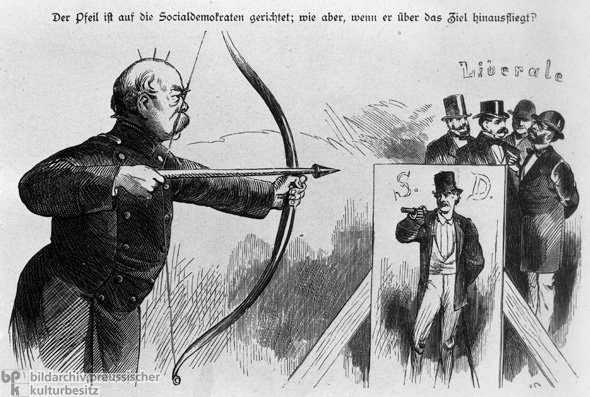













INTRODUCTION | DOCUMENTS | IMAGES | MAPS | EDITOR
|
The caption to this Kladderadatsch cartoon reads: “The arrow is aimed at the Social Democrats; but what if it overshoots the mark?” The journal accurately reflected Bismarck’s intention to use the two assassination attempts on Kaiser Wilhelm I (May 11 and June 2, 1878) to weaken liberal opposition to his policies. But by attaching the label “S.D.” to the figure of a man holding a revolver, Kladderadatsch unfairly followed Bismarck’s lead in associating Social Democracy as a political movement (and party) with the two would-be assassins. The first of these, Max Hödel, had been expelled from the Social Democratic Workers’ Party before his attempt; in fact, when police searched him they found a membership book of the Christian Social Workers’ Party, which was led by none other than Adolf Stöcker (1835-1904), court preacher to the royal family. The second, Dr. Karl Nobiling, was actually opposed to socialism. No matter. Bismarck successfully whipped up public opinion and called a general Reichstag election for the end of July. When the voting was done, the National Liberal Party had lost 29 of the 128 seats it had held in the previous session; the left-liberal Progressive Party had lost 9 of its 35 seats. Since the Conservatives and Free Conservatives made corresponding gains, the way was open for the passage of the Socialist Law in October 1878 and, not long thereafter, for the split in National Liberal ranks that Bismarck had been aiming for. Source: “Reichstagsauflösung,” Kladderadatsch, vol. 31, no. 31 (July 7, 1878), p. 124.
© Bildarchiv Preußischer Kulturbesitz |
 print version
print version return to image list
return to image list previous image
previous image
